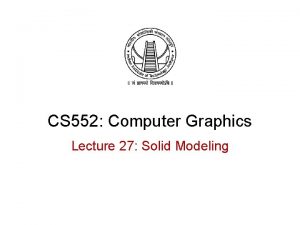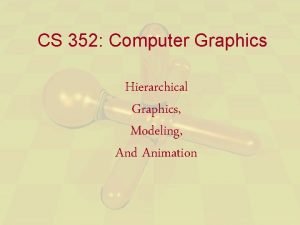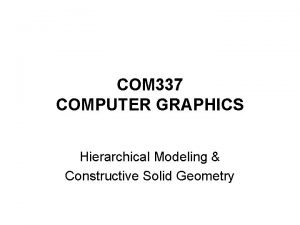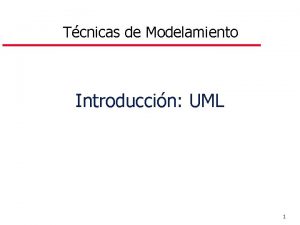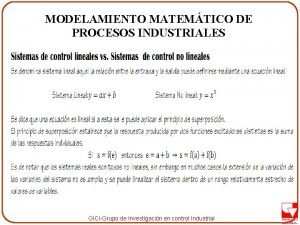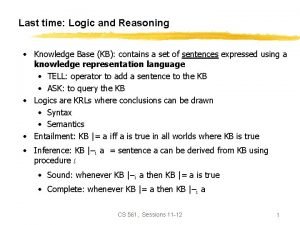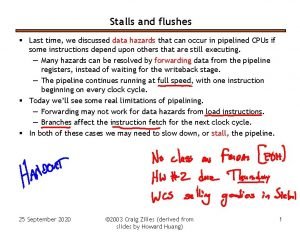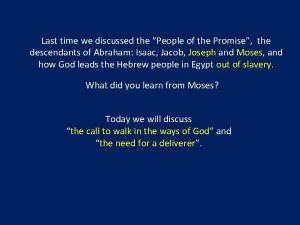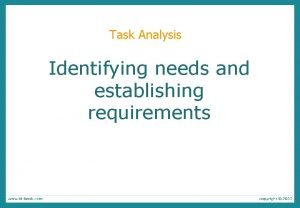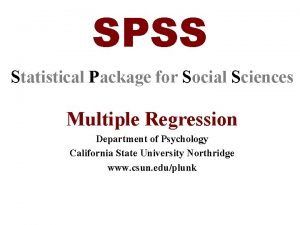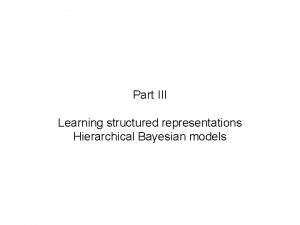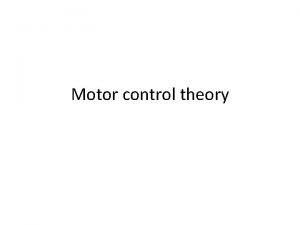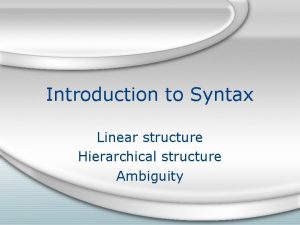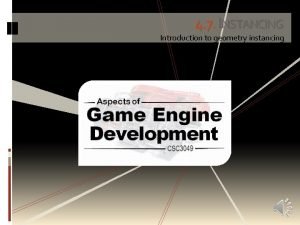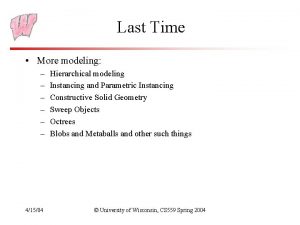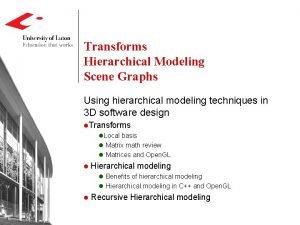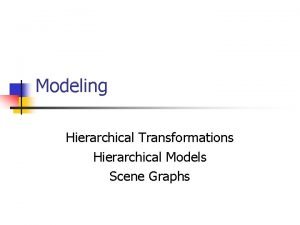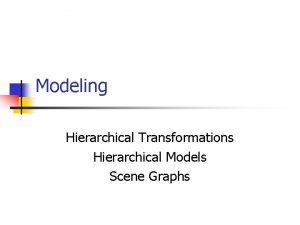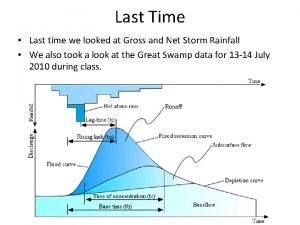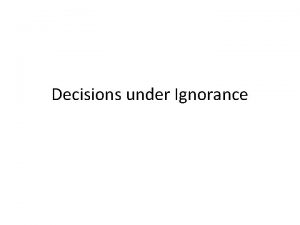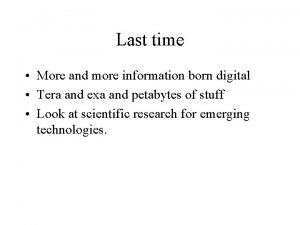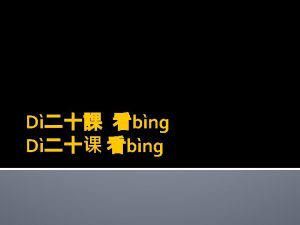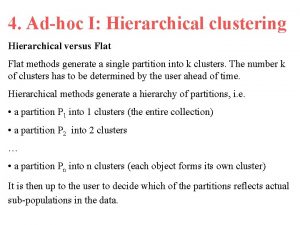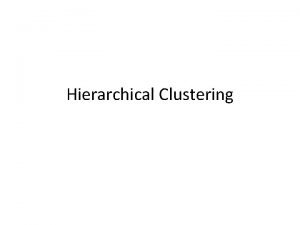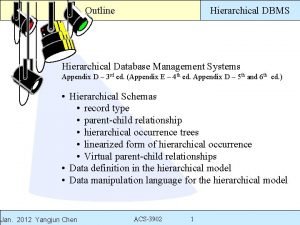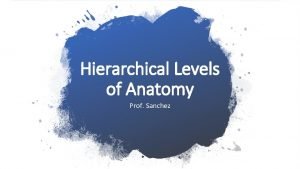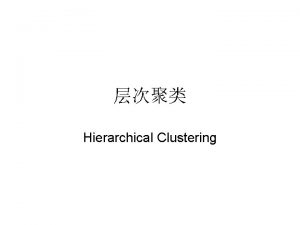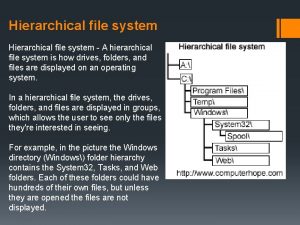Last Time More modeling 113004 Hierarchical modeling Instancing





























- Slides: 29

Last Time • More modeling: – – – 11/30/04 Hierarchical modeling Instancing and Parametric Instancing Constructive Solid Geometry Sweep Objects Octrees © University of Wisconsin, CS 559 Fall 2004

Today • • Subdivision schemes Implicit surfaces Homework 6 due in class Project 3 ongoing 11/30/04 © University of Wisconsin, CS 559 Fall 2004

Smooth versus General • Polygon meshes are very general, but hard to model with – In a production context (film, game), creating a dense, accurate mesh requires lots of work – Biggest problem is smoothness • We desire a way to “smooth out” a polygonal mesh – We can model at a coarse level, and automatically fill in the smooth parts • Subdivision surfaces are part of the answer 11/30/04 © University of Wisconsin, CS 559 Fall 2004

Subdivision Schemes • Basic idea: Start with something coarse, and refine it into smaller pieces, smoothing along the way – We will see how it can be used for modeling specific objects, and as a modeling scheme in itself • In this lecture: – Subdivision for tessellating a sphere – Subdivision for fractal surfaces – General subdivision surfaces 11/30/04 © University of Wisconsin, CS 559 Fall 2004

Tessellating a Sphere • Spheres are frequently parameterized in polar coordinates: – Note the singularity at the poles • Tessellation: The process of approximating a surface with a polygon mesh • One option for tessellating a sphere: – Step around and up the sphere in constant steps of and – Problem: Polygons are of wildly different sizes, and some vertices have very high degree 11/30/04 © University of Wisconsin, CS 559 Fall 2004

Subdivision Method • Begin with a course approximation to the sphere, that uses only triangles – Two good candidates are platonic solids with triangular faces: Octahedron, Isosahedron – They have uniformly sized faces and uniform vertex degree Octahedron • Repeat the following process: – Insert a new vertex in the middle of each edge – Push the vertices out to the surface of the sphere – Break each triangular face into 4 triangles using the new vertices 11/30/04 © University of Wisconsin, CS 559 Fall 2004 Isosahedron

The First Stage Each face gets split into 4: 11/30/04 Each new vertex is degree 6, original vertices are degree 4 © University of Wisconsin, CS 559 Fall 2004

Sphere Subdivision Advantages • All the triangles at any given level are the same size – Relies on the initial mesh having equal sized faces, and properties of the sphere • The new vertices all have the same degree – Mesh is regular (or uniform) in newly generated areas – This is a property we will see later in subdivision surfaces – Makes it easier to analyze what happens to the surface • The location and degree of existing vertices does not change – The only extraordinary points lie on the initial mesh – Extraordinary points are those with degree different to the uniform areas 11/30/04 © University of Wisconsin, CS 559 Fall 2004

Fractal Surfaces • Fractals are objects that show self similarity – The word is overloaded – it can also mean other things • Landscapes and coastlines are considered fractal in nature – Mountains have hills on them that have rocks on them and so on – Continents have gulfs that have harbors that have bays and so on • Subdivision is the natural way of building fractal surfaces – Start with coarse features, Subdivide to finer features – Different types of fractals come from different subdivision schemes and different parameters to those schemes 11/30/04 © University of Wisconsin, CS 559 Fall 2004

Fractal Terrain (1) • Start with a coarse mesh – Vertices on this mesh won’t move, so they can be used to set mountain peaks and valleys – Also defines the boundary – Mesh must not have dangling edges or vertices • Every edge and every vertex must be part of a face • Also define an “up” direction • Then repeatedly: – Add new vertices at the midpoint of each edge, and randomly push them up or down – Split each face into four, as for the sphere 11/30/04 © University of Wisconsin, CS 559 Fall 2004

Fractal Terrain Example A mountainside 11/30/04 © University of Wisconsin, CS 559 Fall 2004

Fractal Terrain Details • There are options for choosing where to move the new vertices – Uniform random offset – Normally distributed offset – small motions more likely – Procedural rule – eg Perlin noise • Reducing the offset of new points according to the subdivision level is essential – Define a scale, s, and a ratio, k, and at each level: si+1=ksi • Colors are frequently chosen based on “altitude” 11/30/04 © University of Wisconsin, CS 559 Fall 2004

Fractal Terrain Algorithm • The hard part is keeping track of all the indices and other data • Same algorithm works for subdividing sphere Split_One_Level(struct Mesh terrain) Copy old vertices for all edges Create and store new vertex Create and store new edges for all faces Create new edges interior to face Create new faces Replace old vertices, edges and faces 11/30/04 © University of Wisconsin, CS 559 Fall 2004

Subdivision Operations • Split an edge, create a new vertex and two new edges – Each edge must be split exactly once – Need to know endpoints of edge to create new vertex • Split a face, creating new edges and new faces based on the old edges and the old and new vertices – Require knowledge of which new edges to use – Require knowledge of new vertex locations 11/30/04 © University of Wisconsin, CS 559 Fall 2004

Data Structure Issues • We must represent a polygon mesh so that the subdivision operations are easy to perform • Questions influencing the data structures: – What information about faces, edges and vertices must we have, and how do we get at it? – Should we store edges explicitly? – Should faces know about their edges? 11/30/04 © University of Wisconsin, CS 559 Fall 2004

General Subdivision Schemes • Subdivision schemes can also be used where there is no “target” surface • They aim to replace a polygonal mesh with a smooth surface that approximates the coarse mesh • There are many schemes: – – – 11/30/04 Butterfly scheme (for triangular meshes) Catmull-Clark subdivision (for mostly rectangular meshes) Loop’s scheme (for triangular meshes) Modified butterfly scheme (for triangular meshes) Many more… © University of Wisconsin, CS 559 Fall 2004

Modified Butterfly Scheme • Subdivides the same way we have been discussing – Each edge is split – Each face is split into four • Rules are defined for computing the splitting vertex of each edge • Basic rule for a uniform region – Splitting an edge with endpoints that have degree 6 – As before, all new interior vertices will have degree 6 – Take a weighted sum of the neighboring vertices – Weights define rules • http: //www. gamasutra. com/features/20000411/sharp_01. htm 11/30/04 © University of Wisconsin, CS 559 Fall 2004

Modified Butterfly Scheme c b a d c b c • Multiply each vertex by its weight and sum them up • w is a control parameter – determines how closely the shape conforms to the original mesh 11/30/04 © University of Wisconsin, CS 559 Fall 2004

Data Structures • Given an edge, how do we find a’s, b’s, c’s, and d’s? • What do we know about the number of edges out of a? • Key idea: Store the edges out of each vertex in an ordered list c b c a a d 11/30/04 c b © University of Wisconsin, CS 559 Fall 2004 d c

Modified Butterfly Scheme • The butterfly scheme must be modified to deal with edges with an endpoint of degree 6 • In that case, compute new vertex based on only the neighbors of the extraordinary vertex • If an edge has two extraordinary endpoints, average the results from each endpoint to get the new endpoint • The modified butterfly scheme is provably continuous about extraordinary vertices – Proof formulates subdivision as a matrix operator and does eigenanalysis of subdivision matrix 11/30/04 © University of Wisconsin, CS 559 Fall 2004

Modified Butterfly Scheme e 3 e 2 e 0 v e. N-3 11/30/04 v is the extraordinary vertex e 1 e. N-2 e. N-1 © University of Wisconsin, CS 559 Fall 2004

Boundaries • Meshes with boundaries, or sharp edges, pose problems • Boundaries are simpler: split edges on the boundary, but do not move the new vertex – place it at the edge midpoint – Vertices on the boundary will probably be extraordinary • Sharp corners need special rules – beyond our scope 11/30/04 © University of Wisconsin, CS 559 Fall 2004

Modified Butterfly Example • Notes: – The mesh is uniform everywhere except the original vertices – It interpolates the original vertices – It has smoothed out the underlying mesh 11/30/04 © University of Wisconsin, CS 559 Fall 2004

Implicit Functions • Some surfaces can be represented as the vanishing points of functions (defined over 3 D space) – Places where a function f(x, y, z)=0 • Some objects are easy represent this way – Spheres, ellipses, and similar – More generally, quadratic surfaces: – Shapes depends on all the parameters a, b, c, d, e, f, g 11/30/04 © University of Wisconsin, CS 559 Fall 2004

Blobs and Metaballs • Define the location of some points, pi • For each point, define a function on the distance to a given point, D(x, pi) • Sum these functions up, and use them as an implicit function • Often, use Gaussian functions of distance, or other forms – Various results are called blobs or metaballs 11/30/04 © University of Wisconsin, CS 559 Fall 2004

Example with Blobs Rendered with POVray. Not everything is a blob, but the characters are. 11/30/04 © University of Wisconsin, CS 559 Fall 2004

Blob Math • Implicit equation: • The wi are weights – just numbers • The gi are functions, one common choice is: – ci and i are parameters 11/30/04 © University of Wisconsin, CS 559 Fall 2004

Rendering Implicit Surfaces • Some methods can render then directly – Raytracing - find intersections with Newton’s method • For polygonal renderer, must convert to polygons – Marching Cubes algorithm – Also used for finding iso-surfaces, or level sets, in volume data 11/30/04 © University of Wisconsin, CS 559 Fall 2004

Implicit Surfaces Summary • Advantages: – Good for organic looking shapes eg human body – Good for extracting surfaces from volume representations, such as water surfaces in fluid simulation – Easy inside/outside testing • Disadvantages: – Difficult to render – Difficult to control when animating 11/30/04 © University of Wisconsin, CS 559 Fall 2004
 Lirik lagu more more more we praise you
Lirik lagu more more more we praise you More more more i want more more more more we praise you
More more more i want more more more more we praise you Solid
Solid Computer graphics
Computer graphics Hierarchical modeling in computer graphics
Hierarchical modeling in computer graphics I
I Hlm hierarchical linear modeling
Hlm hierarchical linear modeling Helen c erickson
Helen c erickson Relational vs dimensional data modeling
Relational vs dimensional data modeling Start time end time and elapsed time
Start time end time and elapsed time The more you take the more you leave behind
The more you take the more you leave behind The more you study the more you learn
The more you study the more you learn Aspire not to
Aspire not to Example of inertia
Example of inertia Knowing more remembering more
Knowing more remembering more The more i give to thee the more i have
The more i give to thee the more i have More choices more chances
More choices more chances Human history becomes more and more a race
Human history becomes more and more a race For the last time sentence
For the last time sentence Peter what were you doing last night homework
Peter what were you doing last night homework Stalls
Stalls Last time we discussed
Last time we discussed Hierarchical task analysis
Hierarchical task analysis Hierarchical linear regression spss
Hierarchical linear regression spss Flat addressing vs hierarchical addressing
Flat addressing vs hierarchical addressing Variance of error term in regression
Variance of error term in regression Hierarchical bayesian model
Hierarchical bayesian model Hierarchical bayesian model
Hierarchical bayesian model Motor program based theory
Motor program based theory Structural ambiguity nedir
Structural ambiguity nedir


